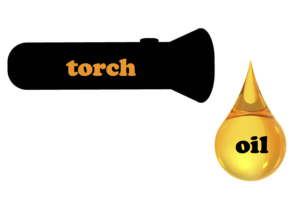“Torch oil” is a term which is usually applied to a gas oil that is burned in FCC regenerators, to supply necessary heat requirements during startup, shutdown, or feed-outage conditions, when coke is not being produced in the reactor. It is injected usually through special nozzles which discharge into the dense catalyst bed of a regenerator.
Requirements for Torch Oil Lightoff
Almost any gas oil can be utilized as torch oil to an FCC unit. However, it is essential to ensure that the oil lights off properly when injected. Torch oil that does not ignite at the injection points in the dense bed will pass into the upper zones of the vessel, i.e. dilute phase, cyclones, and overhead system, where it can ignite, possibly even explode, with obvious undesirable consequences.
It should be recognized that different gas oils have different ignition characteristics. Generally, the lighter the oil, the higher is its ignition temperature.
Nozzles used for torch oil should be properly designed for the service. This usually involves a reasonably high pressure drop, possibly with steam injection, to achieve adequate atomization.
The catalyst dense bed temperature should be safely above the ignition temperature of the gas oil before it is injected. For virgin VGO, this is usually specified as a minimum temperature of 700 to 750°F (370 – 400°C). In addition, there should be an adequate depth of catalyst above the T.O. nozzles, to ensure proper ignition of the oil, and efficient dispersion of the heat into the catalyst bed. Some refiners specify a minimum bed coverage of about 5 ft. (1.5 m) above the nozzles.
When Should Torch Oil Be Used
Obviously, it is necessary to use torch oil during a unit startup, when heat is required to heat the unit catalyst in preparation for introduction of feed, and often during a unit shutdown, to control the rate of unit cooldown.
Torch oil is also used when it is necessary to remove feed during normal operation, possibly due to an emergency condition. Often, the catalyst can be kept circulating between regenerator and reactor during the feed outage, with appropriate temperatures being maintained by torch oil injection to the regenerator dense bed. This holding condition can be maintained indefinitely.
However, there is a downside to continuous torch oil use for long periods of time; that is, deactivation of the unit catalyst inventory. Localized high temperatures at the torch oil nozzles are believed to be the cause of that deactivation. Generally, maintaining this condition for more than about two days is found to be uneconomic. There is a balance between maintaining the catalyst inventory hot in the unit, and accepting the resulting catalyst deactivation, versus taking the time to withdraw the catalyst and re-load it later when the unit is again ready to resume operations. 
One factor which can minimize the degree of catalyst deactivation with torch oil usage is to employ multiple torch oil nozzles in the regenerator. This lessens the concentration of high temperature heat released in a single localized zone of the bed.
2 responses to “Implications of using “Torch Oil””
Leave a Reply
You must be logged in to post a comment.







There are many ways to increase regen temperature, and during S/U, S/D, emergencies the use of torch oil is quite suitable. But in normal operation, it kills catalyst more than the other options. Reduce excess O2 to regen if full combustion, increase air if partial combustion, increase feed preheat (esp. if you have preheat furnace), decrease lift / feed steam, reduce stripper steam, in that order for less impact on conversion and cat deactivation than using torch oil. If long term problem, change to higher coke (generally higher RE) catalyst. Torch oil is worst option of the above, for non emergency cases (which include S/U, S/D).
If there is no option to increase Feed preheat temp, and not using Excess O2 for full combustion . What else other options can be to increase the Regen bed temp to reduce the torch oil consumption.